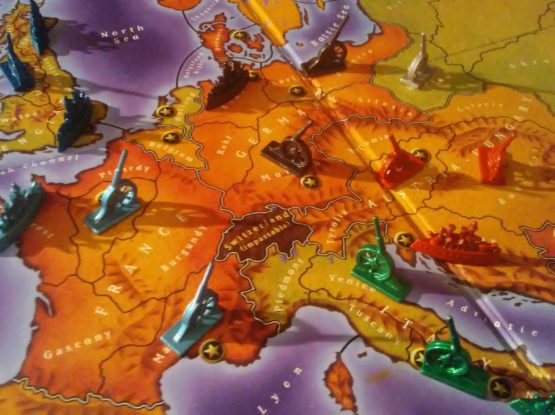Manuf. by: Wizards of the Coast
(Older Versions by Avalon Hill, division of Hasbro)
Players: 2-7
Play Time: 4-6 hours

Diplomacy is quite possibly the greatest design ever for a board game. It is a strategy game, but is centered around negotiating with the other players to support your troops and betray your enemies. Set in early 1900 Europe, it features seven countries battling for European dominance. It can be played with 2-7 players, but the more players you have, the better the game plays. A complete 7-player Diplomacy game is like no other game. I guarantee it!
Diplomacy has such a rich history, too. First designed in the 1950’s, it’s popularity by the mid-70’s actually sparked face-to-face tournaments. Since then, it’s been played by old-fashioned snail-mail, with games taking months to complete, to moderated internet games and communications via e-mail. The tournament Diplomacy scene continues as well, including a North American Diplomacy Championship (DipCon) and a World Diplomacy Championship (World DipCon)being held in different locations around the globe every year. I’ve had the fortunate experience of playing in each the DipCon and the World DipCon back in early 2000’s. I can’t even justly describe it; those tournament face-to-face games of Diplomacy have been some of the most exciting games I’ve ever played. Moreover, Diplomacy has been rumored to have been played by many famous figures throughout history, including John F. Kennedy, Henry Kissinger, and Walter Cronkite.
The game board hasn’t changed in 70 years. All units are worth the same value. And there is no luck involved. In saying that, it sounds like a simplistic game, but believe me, it is one of the hardest games to master. That’s mainly because of the required human interaction. No matter how good of a strategic mastermind you think you are, it’s nearly impossible win without actually negotiating with other players (the exception being the two-player variant).
Players start out in one of seven countries, representing the main powers leading up to World War I (Germany, England, France, Italy, Austria-Hungary, Turkey and Russia). These can be assigned randomly or by bidding on your favorite. Each country controls 3 production centers (or 4 for Russia), and a corresponding military unit. There are only 2 kinds of units, armies and fleets; they both have a power of one and the game set-up always uses the same configuration and position of armies and fleets, which also gives the game some historical relevance. The goal of the game is to eventually control more than half of the total production centers on the game board. There are 34 total production centers, so a player wins when they control 18 of them at the end of a year.
The turn (or year) is separated into 3 phases; Spring, Fall and Winter. Spring and Fall are move phases, and Winter is a build phase. You get to build more units in the Winter phase, if you manage to control a new production center in the Fall phase of that year. A negotiation period takes place before each of the Spring and Fall move phases. During the negotiation period, you visit with other players or a group of other players in private, and try to make your case for support, make treaties, agree upon de-militarized zones; basically, anything you can negotiate with the other players. But here’s the catch, players don’t actually have to abide by anything that was agreed upon. If fact, you’re probably going to have to back out on some of the agreements you make!
When it’s time to finish the move phase, each player writes their orders down and submits them. All moves are processed at the
same time, and everyone finds out together how the moves pan out. This is the usually the most exciting point of the game when you find out whether your negotiations were successful or not! As the game moves on, alliances will change, promises that were made will probably be broken, and subterfuge is revealed! It’s actually a pretty ingenious way to play a game.
Now, you cannot play Diplomacy without some thick skin, and you shouldn’t hold grudges after the game is finished either. Remember, it is just a game and you’re probably playing it with friends, so go into the experience with an open mind. It really is a fantastic way of simulating being a leader of a country!
In the earliest versions, units were represented with wooden blocks. You have to actually search around to find one of these older versions of the game. During later printings of the game by Avalon Hill, the units were beautifully crafted metal pieces. However, the latest version of the game manufactured by Wizards of the Coast, now uses cardboard cutouts to represent units. While, they are a little harder to distinguish between countries, it does bring the cost down some. You can still find the Avalon Hill version of the game, but just keep in mind that you’re going to spend a lot more.
In conclusion, the game of Diplomacy is a very unique experience. It’s certainly been a favorite at the Table over the years, especially with more players, because the interactions you create is unlike anything you’ll find in other games. I highly recommend this game to anyone willing to try a different style of game play!
Click these links to purchase!
